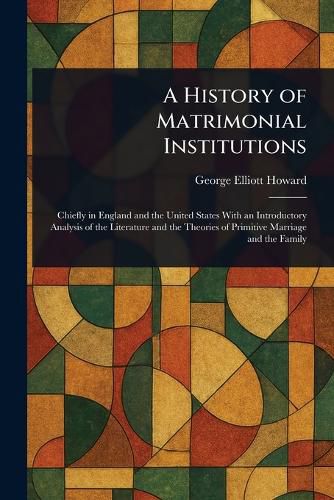Readings Newsletter
Become a Readings Member to make your shopping experience even easier.
Sign in or sign up for free!
You’re not far away from qualifying for FREE standard shipping within Australia
You’ve qualified for FREE standard shipping within Australia
The cart is loading…






This title is printed to order. This book may have been self-published. If so, we cannot guarantee the quality of the content. In the main most books will have gone through the editing process however some may not. We therefore suggest that you be aware of this before ordering this book. If in doubt check either the author or publisher’s details as we are unable to accept any returns unless they are faulty. Please contact us if you have any questions.
Delve into the historical complexities of marriage and family life with "A History of Matrimonial Institutions, Vol. 3 of 3" by George Elliott Howard. This meticulously researched volume provides a comprehensive overview of matrimonial institutions, offering insights into the evolution of family law and social norms surrounding marriage and divorce.
A vital resource for those interested in social history and the development of families, this book explores the historical context of marriage, its legal frameworks, and its impact on society. Explore the sociological aspects of matrimonial institutions and their transformation over time.
This volume, part of a larger series, stands as a significant contribution to the understanding of how societies have structured and regulated intimate relationships. A valuable addition to any library, it provides historical context for contemporary discussions about marriage and family.
This work has been selected by scholars as being culturally important, and is part of the knowledge base of civilization as we know it.
This work is in the public domain in the United States of America, and possibly other nations. Within the United States, you may freely copy and distribute this work, as no entity (individual or corporate) has a copyright on the body of the work.
Scholars believe, and we concur, that this work is important enough to be preserved, reproduced, and made generally available to the public. We appreciate your support of the preservation process, and thank you for being an important part of keeping this knowledge alive and relevant.
$9.00 standard shipping within Australia
FREE standard shipping within Australia for orders over $100.00
Express & International shipping calculated at checkout
This title is printed to order. This book may have been self-published. If so, we cannot guarantee the quality of the content. In the main most books will have gone through the editing process however some may not. We therefore suggest that you be aware of this before ordering this book. If in doubt check either the author or publisher’s details as we are unable to accept any returns unless they are faulty. Please contact us if you have any questions.
Delve into the historical complexities of marriage and family life with "A History of Matrimonial Institutions, Vol. 3 of 3" by George Elliott Howard. This meticulously researched volume provides a comprehensive overview of matrimonial institutions, offering insights into the evolution of family law and social norms surrounding marriage and divorce.
A vital resource for those interested in social history and the development of families, this book explores the historical context of marriage, its legal frameworks, and its impact on society. Explore the sociological aspects of matrimonial institutions and their transformation over time.
This volume, part of a larger series, stands as a significant contribution to the understanding of how societies have structured and regulated intimate relationships. A valuable addition to any library, it provides historical context for contemporary discussions about marriage and family.
This work has been selected by scholars as being culturally important, and is part of the knowledge base of civilization as we know it.
This work is in the public domain in the United States of America, and possibly other nations. Within the United States, you may freely copy and distribute this work, as no entity (individual or corporate) has a copyright on the body of the work.
Scholars believe, and we concur, that this work is important enough to be preserved, reproduced, and made generally available to the public. We appreciate your support of the preservation process, and thank you for being an important part of keeping this knowledge alive and relevant.